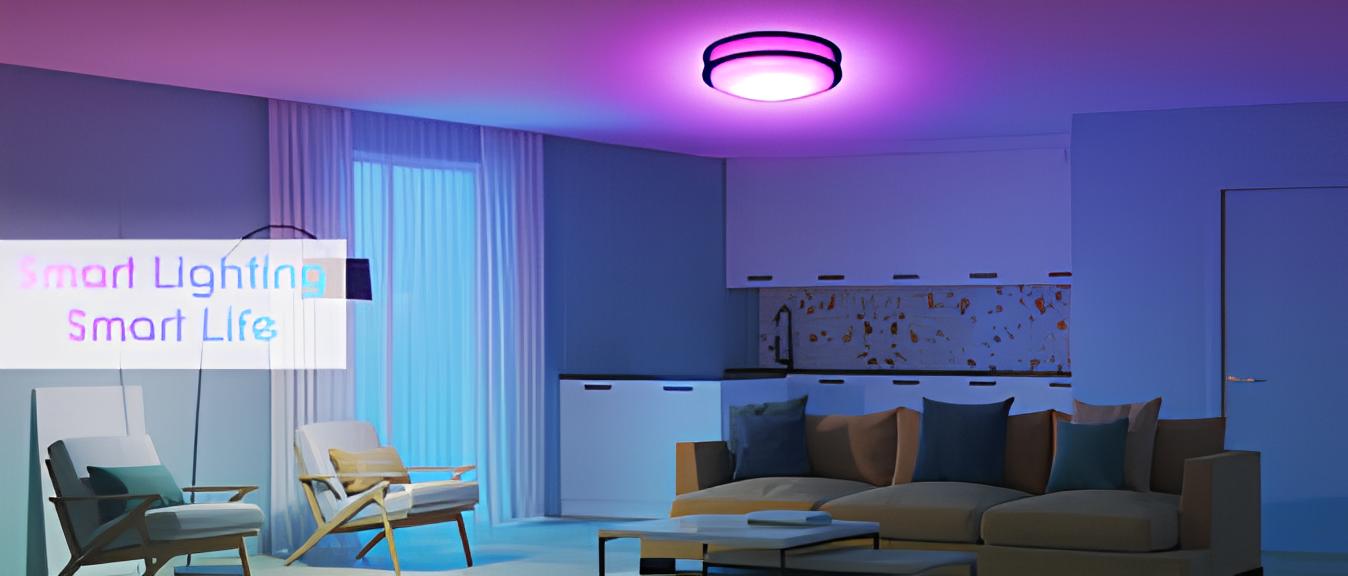Are you tired of manually adjusting the brightness or switching your LED lights to suit different scenes and needs? If so, it's time to consider upgrading to a smart lighting system! Smart lighting not only frees you from tedious tasks but also allows you to remotely control and customize your lighting through your smartphone or voice assistants. In this article, we will explore how smart lighting works and the numerous benefits it brings to LED light users.
TABLE OF CONTENTS
Traditional lighting vs. Smart Lighting
Traditional lighting, typically controlled by standard switches or dimmers, requires manual adjustments. While traditional light fixtures serve the purpose of providing basic illumination well, they lack flexibility and intelligent features.
On the other hand, smart lighting is a modern solution that can be controlled through smartphone apps or voice assistants. Users can adjust brightness, set schedules, and even customize lighting effects based on scenes and moods. Additionally, smart lighting systems often come equipped with sensors that can automatically adjust lighting based on ambient light or human presence, leading to energy savings and smarter lighting management.

The Capabilities of Smart Lighting
Smart lighting systems come with a host of powerful features. They can not only enhance your lighting experience but also offer endless convenience and personalized options to users. Here are the main functionalities of smart lighting:
- Remote Control: With the app on your smartphone or tablet, users can control the on/off and brightness of their lights anytime, anywhere. No matter where you are, you can adjust and manage your lighting in real-time.
- Timers and Scheduling: Smart lighting systems allow you to set timers and schedules for your lights. Based on your daily routines, you can have the lights turn on or off automatically at specified times, achieving true automated lighting.
- Scene Setting: Smart lighting systems support setting specific lighting effects for different scenarios. Whether it's reading, partying, or relaxing, you can choose a suitable lighting scene to add color to your life.
- Color and Dimming: Smart lights often have color temperature and color adjustments. Users can adjust the color and brightness of the light according to their needs or moods, creating an ideal ambiance.
- Voice Control: Many smart lighting systems are compatible with smart assistants such as Amazon's Alexa or Google Home and support voice control. This means that users can adjust the lights through voice commands, without the need for manual operation.
- Energy-saving and Environmental Protection: The timing, scheduling, and automation features of smart lighting help save energy, reducing unnecessary lighting and electricity waste. Additionally, many smart lights use LED bulbs, which are more energy-efficient and have a longer lifespan compared to traditional lights.
- Smart Home Integration: Smart lighting systems can seamlessly integrate with other smart home devices (such as smart locks, smart thermostats, etc.), forming a smart home system together and providing a more intelligent and comfortable living experience.
From the above introduction, we can see the advantages and uniqueness of smart lighting systems in terms of functionality. For users seeking convenience, energy-saving, and personalized lighting experiences, smart lighting is undoubtedly an ideal choice.

How Smart Lighting Works
- How smart lights communicate with devices
- Smart lighting combines wireless technology, sensors, and software to allow you to control your lights like never before.
- They connect to your devices through Wi-Fi, Zigbee, or Bluetooth, and can be controlled through an app on your phone, or through voice commands with a smart home assistant.
- You can set schedules, adjust brightness, change colors, and even automate lights based on movement or the amount of natural light in a room.
- In summary, smart lighting gives you advanced and flexible control over your lights, customizing them to your needs.
- Systems: Overview of user interface and advanced settings
- Control systems are the key to unlocking the full potential of smart lighting. These are typically accessed through an app on your smartphone or tablet, which allows you to manage all aspects of your smart lights.
- Basic controls include the ability to turn lights on and off, adjust brightness, and change color. More advanced settings might include creating lighting schedules, setting up scenes for specific activities, and integrating your lights with other smart devices for a cohesive smart home experience.
- The user interface is designed to be user-friendly, making it easy to adjust settings and manage your smart lights. With a few taps, you can transform the ambiance of your home.
- In short, the control system is a central part of smart lighting, providing an easy and intuitive way for users to customize their lighting.
- Role in automation and types
- Motion Sensors: These sensors detect movement in a room, triggering lights to turn on or off automatically. This is particularly useful in areas where hands-free operation is beneficial, like bathrooms, hallways, or garages.
- Ambient Light Sensors: These sensors measure the amount of natural light present in a room. They can adjust the brightness of your smart lights accordingly, providing an optimal lighting level at all times.
- Proximity Sensors: These sensors can detect when a specific person or device is nearby, allowing lights to be turned on or off based on their presence.
Sensors play a pivotal role in the functionality of smart lighting, enabling advanced features like automation and adaptive lighting. Here are the most common types of sensors used in smart lighting:
The use of these sensors not only enhances convenience and energy efficiency but also opens up possibilities for more sophisticated lighting effects and schedules, making smart lighting a truly intelligent system.

Benefits of Smart Lighting
- Remote access, control, and voice-activated commands
- Remote Access: With smart lighting, you can control your lights from anywhere with an internet connection. Forgot to turn off the lights before leaving home? No problem. Just use your smartphone to turn them off.
- Control: Whether you're in bed and want to turn off the kitchen lights or in the living room wanting to dim the lights for movie night, smart lighting lets you control every light in your home with the touch of a button.
- Voice-Activated Commands: Integration with voice assistants like Alexa, Google Home, or Siri adds another level of convenience. You can turn lights on or off, dim them, or even change their color, all with simple voice commands.
- These features not only provide comfort and convenience but also contribute to energy efficiency and home security, making smart lighting a worthwhile addition to any home.
- Energy Saving: Reduction in unnecessary lighting
- Scheduled Lighting: With smart lighting, you can set schedules for when your lights turn on and off. For instance, you can program your lights to turn off during the day when everyone is out and to turn back on just before you get home. This reduces the chance of lights being left on when not needed.
- Motion Sensors: As mentioned earlier, motion sensors can detect when someone is in a room and turn lights on or off accordingly. This means lights aren't left on in empty rooms, saving energy.
- Dimming Capabilities: Most smart lights allow you to adjust their brightness. By dimming lights when full brightness isn't necessary, you can save electricity.
- Adaptive Lighting: Some smart lights can adapt to the level of natural light in a room, dimming or brightening as needed. This uses the power of ambient light sensors and results in less artificial light and, therefore, less energy consumption.
- Personalizing ambiance based on mood or event
- Mood Lighting: Feeling relaxed? Set your lights to a soft warm glow. Hosting a party? Change them to a fun, vibrant color. You can adjust color and brightness to create the perfect atmosphere for any mood.
- Event-Based Lighting: If you're hosting a dinner party, you can create a soft, inviting atmosphere. If you're watching a movie, you can recreate a cinema-like experience with dimmed lights.
- Time-Based Lighting: You can automate your lights to match the natural progression of the day. For instance, you can have bright white light during the day, warm light at sunset, and dim light in the evening.
- Room-Specific Lighting: You can customize the lighting in each room based on its function. For example, you might want bright light in the kitchen but soft light in the bedroom.
One of the main benefits of smart lighting is the unparalleled level of convenience it provides. With the power of connectivity and advanced controls, smart lights offer several advantages that make everyday life easier:
Smart lighting is not only about convenience and control; it's also about energy efficiency. One of the significant advantages of smart lights is their potential to reduce unnecessary lighting and, therefore, energy consumption. Here's how:
By intelligently managing your lighting usage, smart lighting can lead to substantial energy savings, reducing your electricity bills and contributing to a greener planet.
Another major benefit of smart lighting is the ability to customize the ambiance of your home to match your mood, the time of day, or the event you're hosting. Here's how you can achieve this:
By offering an incredible level of customization, smart lighting allows you to personalize your home's ambiance, creating the perfect environment for every situation.

Conclusion
In conclusion, smart lighting offers a new world of possibilities when it comes to illuminating our homes. With its advanced capabilities like automation, customization, and remote control, it transforms the simple act of lighting into a dynamic, interactive experience.The energy savings, convenience, and personalization that smart lights provide make them a worthy investment for anyone looking to upgrade their home and their lifestyle. As smart home technology continues to evolve and become more integrated into our daily lives, smart lighting is leading the way.The future of smart lighting is bright, with new technologies and innovations on the horizon that promise to make our homes even more comfortable, efficient, and responsive. So, if you haven't made the switch to smart lighting, now is the perfect time.




Share:
Step by Step: How to Remove Ceiling Light Cover no Screws
Unveiling LED Longevity: How Long Do LED Lights Last?